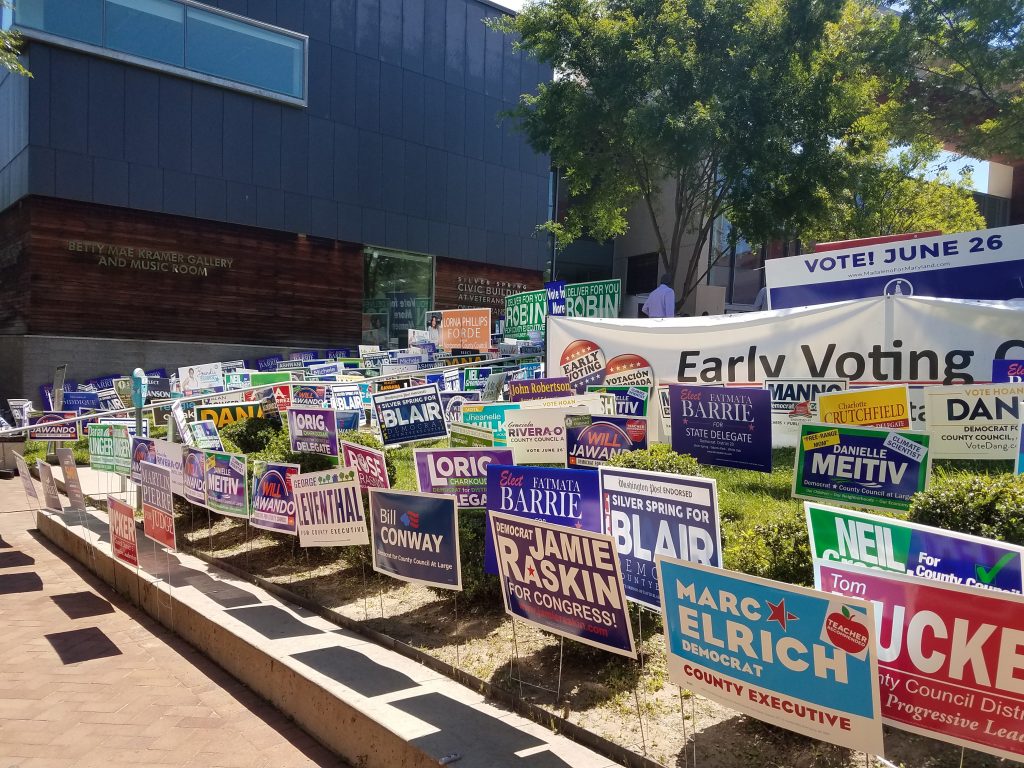There are thirty (that is 3-0) people running for Montgomery County, Maryland Council. Voters are allowed to vote for up to four. There are also eight candidates running in the Democratic primary for Maryland Governor (the incumbent, Larry Hogan, is a Republican and is unopposed). Voters also get to vote for County Executive (six Democrats running), U.S. Senator, U.S. Representative, State Delegates, Judges, even for the Clerk of the Circuit Court. In short, there are a lot of people competing for votes in Montgomery County, Maryland. And with so many people running, it’s a real challenge to stand out.
And it’s because of the crush of candidates that every registered party voter in Montgomery County (where I live) has been inundated with campaign literature. (Read today’s Washington Post story, In Montgomery County, voters face a deluge of campaign literature mailings, about it). And that is all in addition to the countless political commercials that have been airing on both the local TV stations and the political talk shows on cable TV. And the many sponsored ads on Twitter and Facebook. And the ubiquitous lawn signs and placards placed throughout the county.

I know because I have received dozens of door hangers and flyers on my doorstep, dozens of flyers in the mail, tons of emails, and even personalized texts to my cell phone (I am still trying to figure out how they got the number). The most notable piece of campaign literature that I got was a form letter from a candidate stuffed inside a handwritten envelope.
The name of the game
When a race is so crowded, you have to really fight to stand out. When you are running against 29 other candidates, name recognition matters. And so you spend a lot of money to make sure people know and remember your name.
So you need money to succeed in politics
There are two big problems with making name recognition a priority. The first is that you need a lot of money to be able to make people remember your name, which means candidates with the deepest pockets have a big (unfair?) advantage. And indeed, in Montgomery County, two self-made millionaires (David Trone, who is running for U.S. Congress, and David Blair, who is running for Montgomery County Executive) are leading in the amount of money spent. Both these guys are saturating the market with flyers, TV commercials, placards and so forth.
And a stand voters agree with
The second problem is that we don’t vote on name recognition alone. Serious voters (and primary voters tend to be serious) vote on where candidates stand on issues they care about. Name recognition is helpful for sure, but it doesn’t inform voters sufficiently. If voters care about issues, it becomes incumbent on them to research the candidates’ positions. Thankfully, the League of Women Voters publishes a Voters’ Guide. And most candidates have websites.
In the end, you vote for people who reflect your priorities and values, not for the person with the most lawn signs or door hangers. To really stand out in a crowded field, candidates need to be able to communicate who they are, what they stand for, and why they are the better choice. That takes a lot of money, great communications know-how, and superb political skill.
May the best candidates win! And if you live in Maryland, don’t forget to vote on June 26th.
UPDATE: Today, I received an additional five pieces of campaign literature in the mail, three of those promote ONE candidate, and the other is the tenth or so piece I have received from another candidate. Sending three pieces of mail about one candidate strikes me as overkill, and could backfire. Certainly the other candidate, who clearly has very deep pockets, has shown he will spend (waste?) as much money as he can. There’s no added advantage to sending a piece of campaign literature every day. It becomes junk mail, quite literally. Direct mail does not benefit from frequency as does radio/TV.
About Deborah Brody
Deborah Brody writes and edits anything related to marketing communications. Most blog posts are written under the influence of caffeine.


